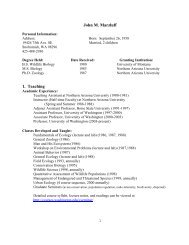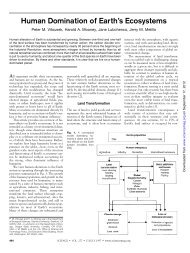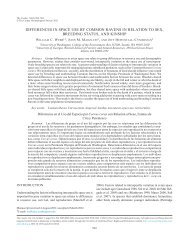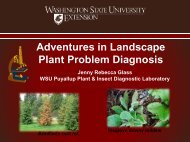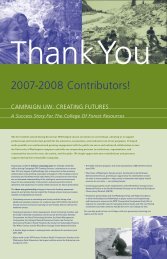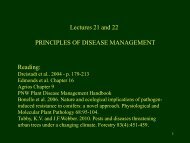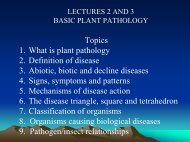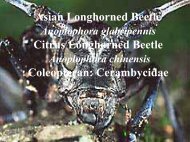Create successful ePaper yourself
Turn your PDF publications into a flip-book with our unique Google optimized e-Paper software.
Ch14 10/5/99 2:19 PM Page 338<br />
338 CHAPTER 14<br />
Figure 14.3<br />
Aerial shoots of western<br />
hemlock dwarf mistletoe<br />
(A. tsugense subsp.<br />
tsugense).<br />
Dwarf mistletoes cause growth reduction, loss of host vigor, poor wood quality,<br />
branch and top kill, and even mortality (Tainter and Baker 1996). Poor-quality<br />
wood results because branch swelling and stem infections cause abnormal grain,<br />
resin impregnation, and spongy woody texture. Branch proliferation and swellings<br />
also increase the size and number of knots. Squirrels also may feed on infected<br />
branches, especially of lodgepole pine, western larch, and Douglas-fir and have<br />
caused “red flagging” in young stands in western Canada.<br />
Dwarf Mistletoe Infection Rating Scheme<br />
A 6-class dwarf mistletoe rating scheme was developed in the western United<br />
States to help foresters and researchers judge the degree of tree infection<br />
(Hawksworth 1977). This scheme, also known as the Hawksworth scheme, is illustrated<br />
in Figure 14.4. The first step is to divide the crown of individual trees into<br />
thirds (top, middle, and bottom). Then each third is rated as 0, 1, or 2 based on<br />
the degree of infection. For example, a rating of 2 is a heavy infection where more<br />
than half of the total number of branches in the third is infected. The final step is<br />
to add the ratings of the three thirds to get a rating for the total tree. The maximum<br />
rating is 6 for a very heavily infected tree.<br />
Ecological Relationships<br />
The distribution of dwarf mistletoe species is strongly influenced by topography,<br />
climate, fire, insect outbreaks, and forest succession. For example, Douglas-fir<br />
dwarf mistletoe does not occur in western Oregon and Washington. The combined<br />
effects of physiography, fire, and forest succession have apparently prevented the<br />
immigration and establishment of A. douglasii in this region. Climatic warming<br />
the last few thousand years has greatly fragmented the populations of dwarf mistletoes<br />
in the southwestern United States (Hawksworth and Wiens 1996).<br />
Wildfires seem to be the most important single factor governing the abundance<br />
and distribution of dwarf mistletoes (Hawksworth and Wiens 1996). Although<br />
high-intensity stand-replacing fires reduce dwarf mistletoe populations, other types<br />
of fires can increase populations. For example, spotty fires leave scattered, live,



